Migrant Children: Psychological Risks and Impact on Development
VerifiedAdded on 2023/04/20
|21
|5983
|319
Essay
AI Summary
This essay examines the primary risks encountered by migrant children and their potential consequences on their overall development, focusing on psychological aspects. It begins by referencing a study by Hicks et al. (2009) to highlight the traumatic experiences of refugee children and their subsequent mental health issues. The analysis is structured around three key themes: identity development, self-representation, and emotional development, covering both adolescence and middle childhood. The essay evaluates claims regarding identity crises, social isolation, and the impact of trauma on cognitive and emotional growth, drawing on various studies and psychological theories. It concludes by summarizing the main points discussed under each theme and offering recommendations for promoting healthy psychological development in migrant children, while also acknowledging the complexity of risk factors and suggesting avenues for future research. Desklib offers a platform for students to access similar essays and study tools.
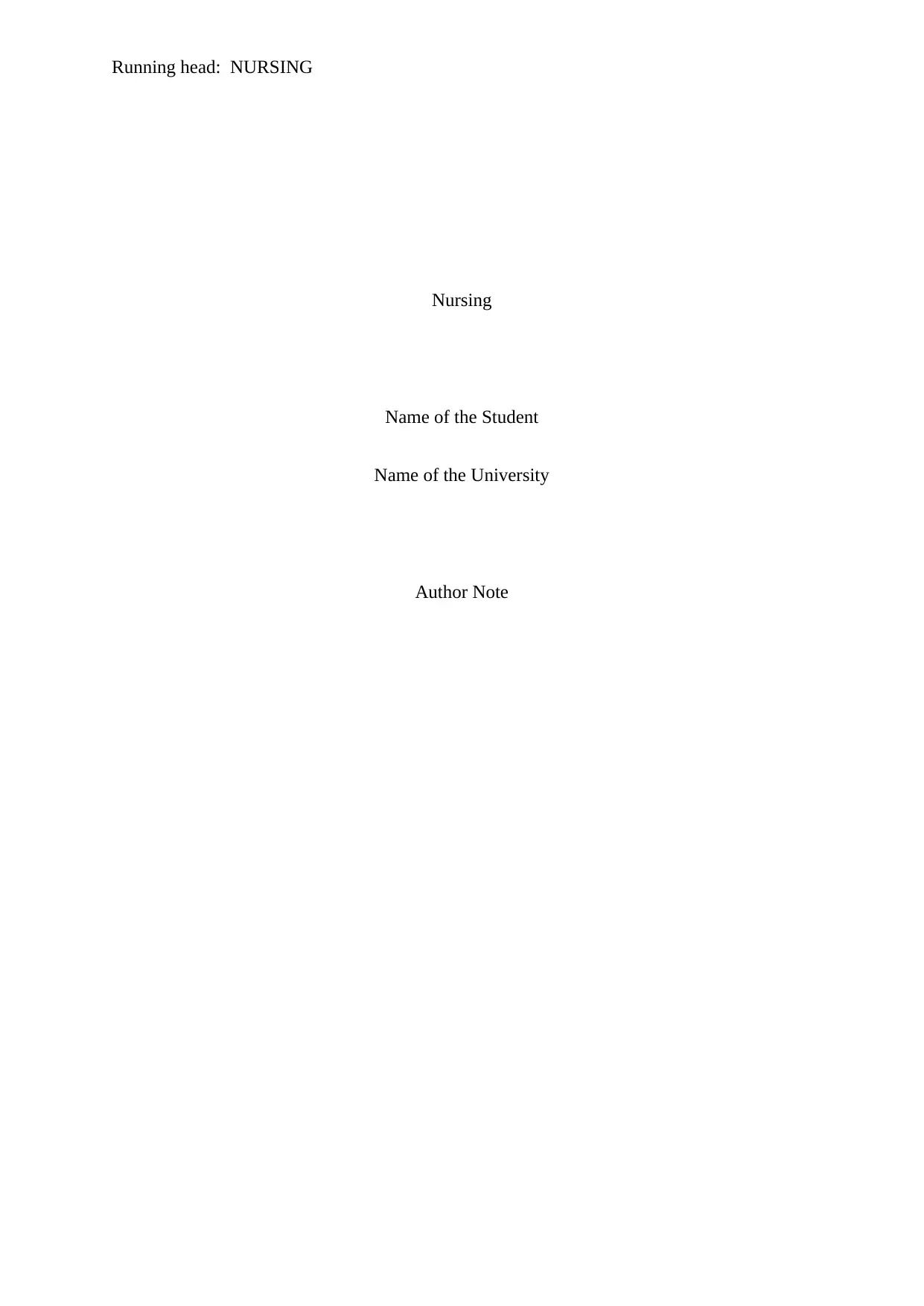
Running head: NURSING
Nursing
Name of the Student
Name of the University
Author Note
Nursing
Name of the Student
Name of the University
Author Note
Paraphrase This Document
Need a fresh take? Get an instant paraphrase of this document with our AI Paraphraser
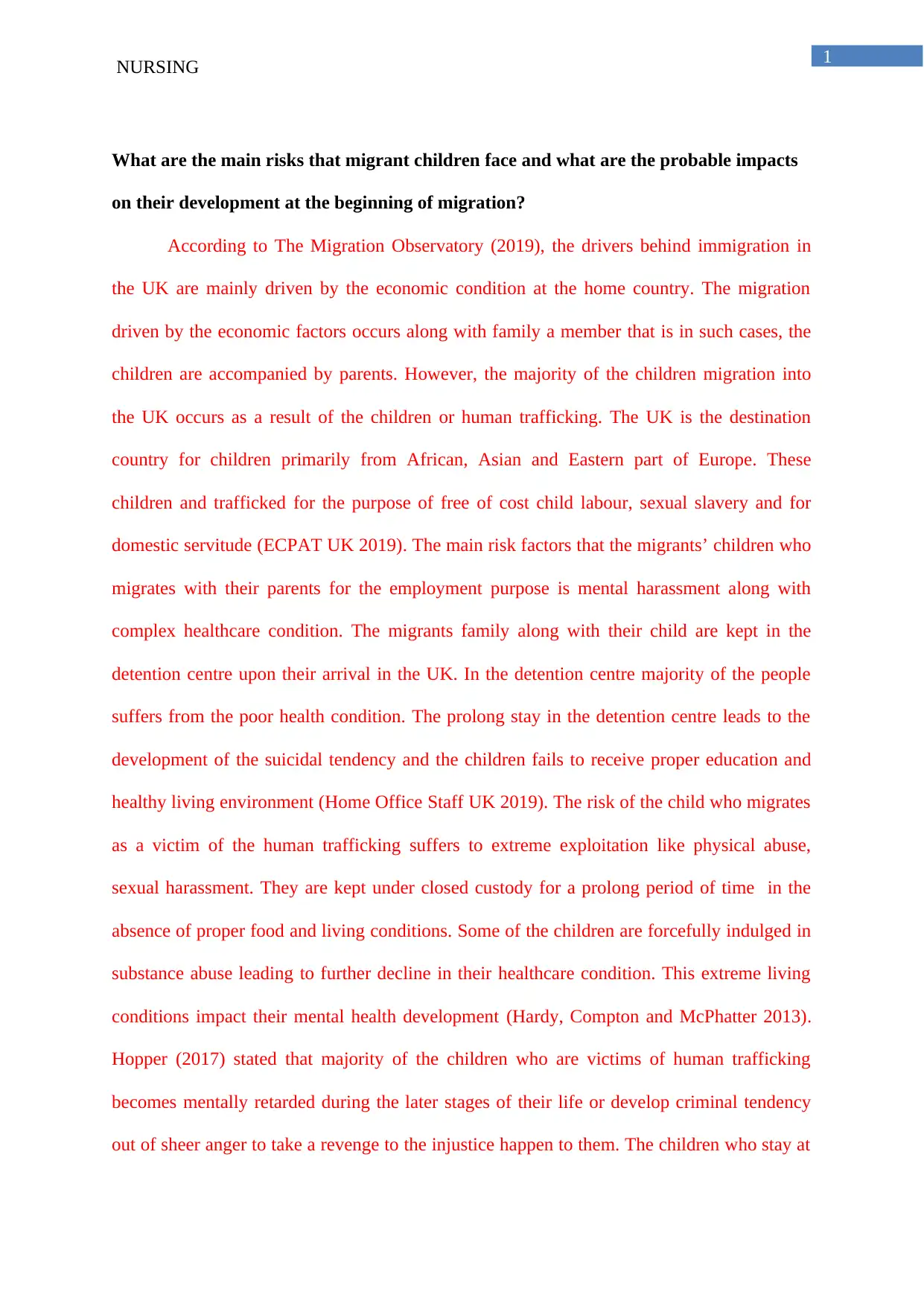
1
NURSING
What are the main risks that migrant children face and what are the probable impacts
on their development at the beginning of migration?
According to The Migration Observatory (2019), the drivers behind immigration in
the UK are mainly driven by the economic condition at the home country. The migration
driven by the economic factors occurs along with family a member that is in such cases, the
children are accompanied by parents. However, the majority of the children migration into
the UK occurs as a result of the children or human trafficking. The UK is the destination
country for children primarily from African, Asian and Eastern part of Europe. These
children and trafficked for the purpose of free of cost child labour, sexual slavery and for
domestic servitude (ECPAT UK 2019). The main risk factors that the migrants’ children who
migrates with their parents for the employment purpose is mental harassment along with
complex healthcare condition. The migrants family along with their child are kept in the
detention centre upon their arrival in the UK. In the detention centre majority of the people
suffers from the poor health condition. The prolong stay in the detention centre leads to the
development of the suicidal tendency and the children fails to receive proper education and
healthy living environment (Home Office Staff UK 2019). The risk of the child who migrates
as a victim of the human trafficking suffers to extreme exploitation like physical abuse,
sexual harassment. They are kept under closed custody for a prolong period of time in the
absence of proper food and living conditions. Some of the children are forcefully indulged in
substance abuse leading to further decline in their healthcare condition. This extreme living
conditions impact their mental health development (Hardy, Compton and McPhatter 2013).
Hopper (2017) stated that majority of the children who are victims of human trafficking
becomes mentally retarded during the later stages of their life or develop criminal tendency
out of sheer anger to take a revenge to the injustice happen to them. The children who stay at
NURSING
What are the main risks that migrant children face and what are the probable impacts
on their development at the beginning of migration?
According to The Migration Observatory (2019), the drivers behind immigration in
the UK are mainly driven by the economic condition at the home country. The migration
driven by the economic factors occurs along with family a member that is in such cases, the
children are accompanied by parents. However, the majority of the children migration into
the UK occurs as a result of the children or human trafficking. The UK is the destination
country for children primarily from African, Asian and Eastern part of Europe. These
children and trafficked for the purpose of free of cost child labour, sexual slavery and for
domestic servitude (ECPAT UK 2019). The main risk factors that the migrants’ children who
migrates with their parents for the employment purpose is mental harassment along with
complex healthcare condition. The migrants family along with their child are kept in the
detention centre upon their arrival in the UK. In the detention centre majority of the people
suffers from the poor health condition. The prolong stay in the detention centre leads to the
development of the suicidal tendency and the children fails to receive proper education and
healthy living environment (Home Office Staff UK 2019). The risk of the child who migrates
as a victim of the human trafficking suffers to extreme exploitation like physical abuse,
sexual harassment. They are kept under closed custody for a prolong period of time in the
absence of proper food and living conditions. Some of the children are forcefully indulged in
substance abuse leading to further decline in their healthcare condition. This extreme living
conditions impact their mental health development (Hardy, Compton and McPhatter 2013).
Hopper (2017) stated that majority of the children who are victims of human trafficking
becomes mentally retarded during the later stages of their life or develop criminal tendency
out of sheer anger to take a revenge to the injustice happen to them. The children who stay at
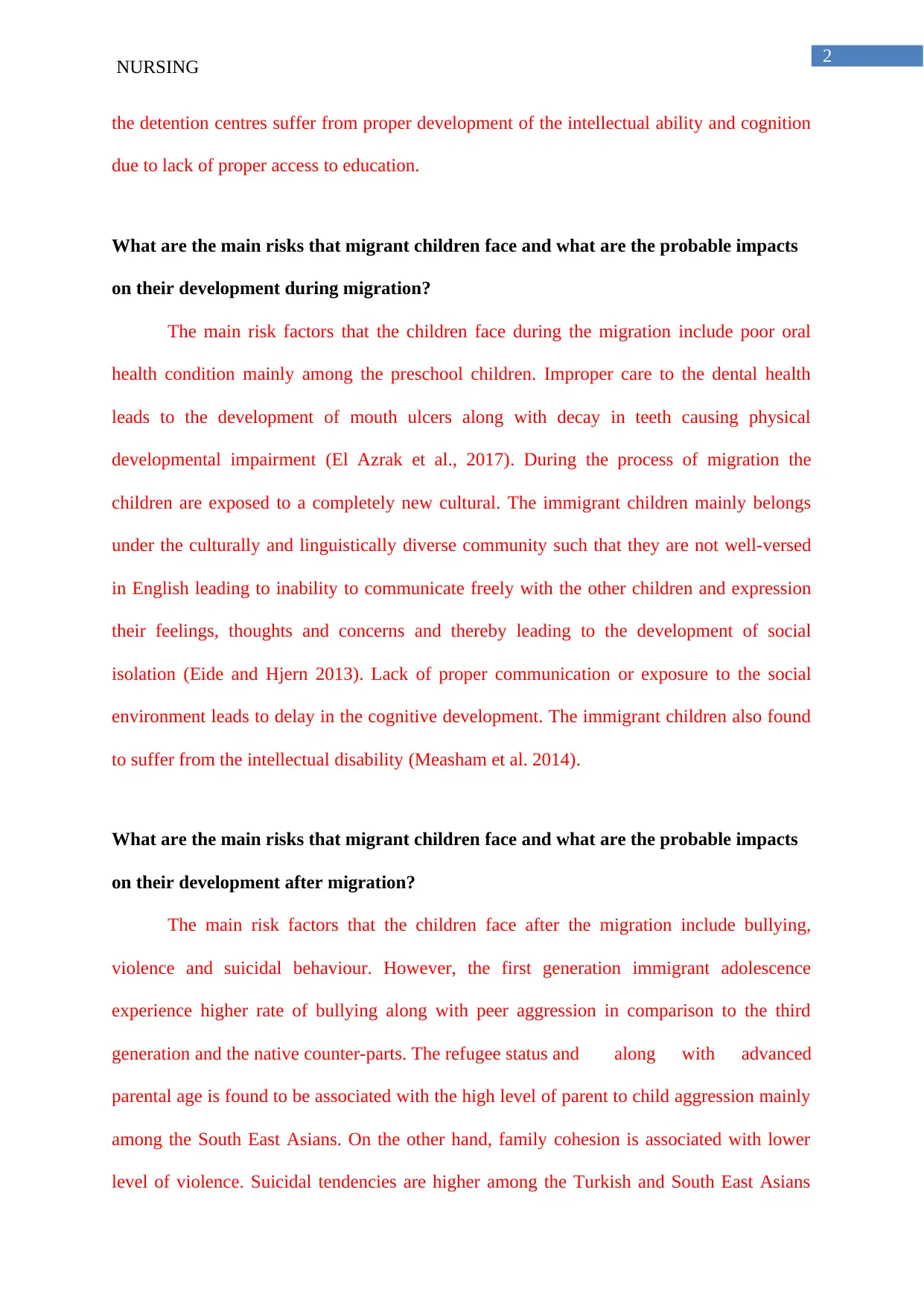
2
NURSING
the detention centres suffer from proper development of the intellectual ability and cognition
due to lack of proper access to education.
What are the main risks that migrant children face and what are the probable impacts
on their development during migration?
The main risk factors that the children face during the migration include poor oral
health condition mainly among the preschool children. Improper care to the dental health
leads to the development of mouth ulcers along with decay in teeth causing physical
developmental impairment (El Azrak et al., 2017). During the process of migration the
children are exposed to a completely new cultural. The immigrant children mainly belongs
under the culturally and linguistically diverse community such that they are not well-versed
in English leading to inability to communicate freely with the other children and expression
their feelings, thoughts and concerns and thereby leading to the development of social
isolation (Eide and Hjern 2013). Lack of proper communication or exposure to the social
environment leads to delay in the cognitive development. The immigrant children also found
to suffer from the intellectual disability (Measham et al. 2014).
What are the main risks that migrant children face and what are the probable impacts
on their development after migration?
The main risk factors that the children face after the migration include bullying,
violence and suicidal behaviour. However, the first generation immigrant adolescence
experience higher rate of bullying along with peer aggression in comparison to the third
generation and the native counter-parts. The refugee status and along with advanced
parental age is found to be associated with the high level of parent to child aggression mainly
among the South East Asians. On the other hand, family cohesion is associated with lower
level of violence. Suicidal tendencies are higher among the Turkish and South East Asians
NURSING
the detention centres suffer from proper development of the intellectual ability and cognition
due to lack of proper access to education.
What are the main risks that migrant children face and what are the probable impacts
on their development during migration?
The main risk factors that the children face during the migration include poor oral
health condition mainly among the preschool children. Improper care to the dental health
leads to the development of mouth ulcers along with decay in teeth causing physical
developmental impairment (El Azrak et al., 2017). During the process of migration the
children are exposed to a completely new cultural. The immigrant children mainly belongs
under the culturally and linguistically diverse community such that they are not well-versed
in English leading to inability to communicate freely with the other children and expression
their feelings, thoughts and concerns and thereby leading to the development of social
isolation (Eide and Hjern 2013). Lack of proper communication or exposure to the social
environment leads to delay in the cognitive development. The immigrant children also found
to suffer from the intellectual disability (Measham et al. 2014).
What are the main risks that migrant children face and what are the probable impacts
on their development after migration?
The main risk factors that the children face after the migration include bullying,
violence and suicidal behaviour. However, the first generation immigrant adolescence
experience higher rate of bullying along with peer aggression in comparison to the third
generation and the native counter-parts. The refugee status and along with advanced
parental age is found to be associated with the high level of parent to child aggression mainly
among the South East Asians. On the other hand, family cohesion is associated with lower
level of violence. Suicidal tendencies are higher among the Turkish and South East Asians
⊘ This is a preview!⊘
Do you want full access?
Subscribe today to unlock all pages.

Trusted by 1+ million students worldwide
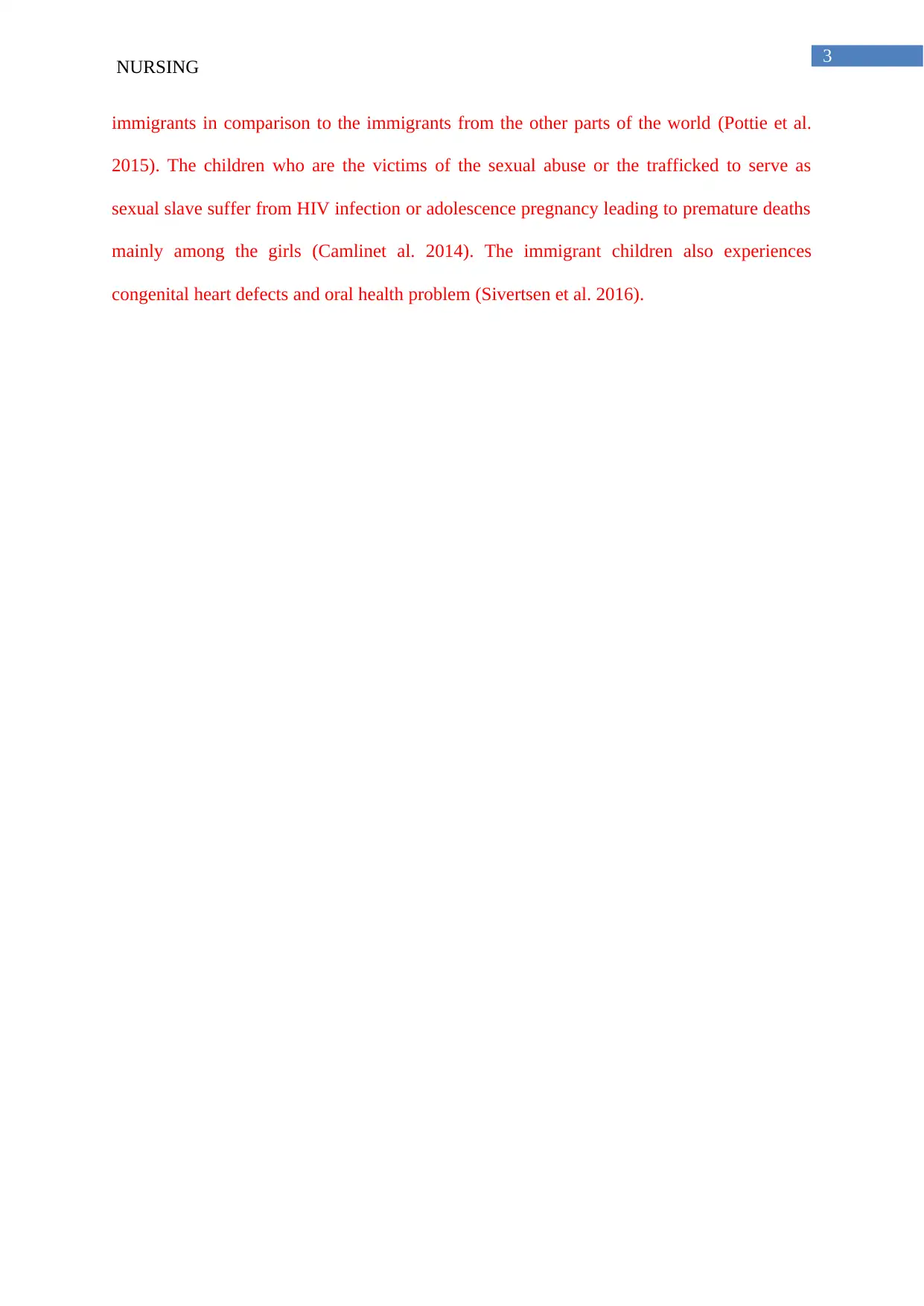
3
NURSING
immigrants in comparison to the immigrants from the other parts of the world (Pottie et al.
2015). The children who are the victims of the sexual abuse or the trafficked to serve as
sexual slave suffer from HIV infection or adolescence pregnancy leading to premature deaths
mainly among the girls (Camlinet al. 2014). The immigrant children also experiences
congenital heart defects and oral health problem (Sivertsen et al. 2016).
NURSING
immigrants in comparison to the immigrants from the other parts of the world (Pottie et al.
2015). The children who are the victims of the sexual abuse or the trafficked to serve as
sexual slave suffer from HIV infection or adolescence pregnancy leading to premature deaths
mainly among the girls (Camlinet al. 2014). The immigrant children also experiences
congenital heart defects and oral health problem (Sivertsen et al. 2016).
Paraphrase This Document
Need a fresh take? Get an instant paraphrase of this document with our AI Paraphraser
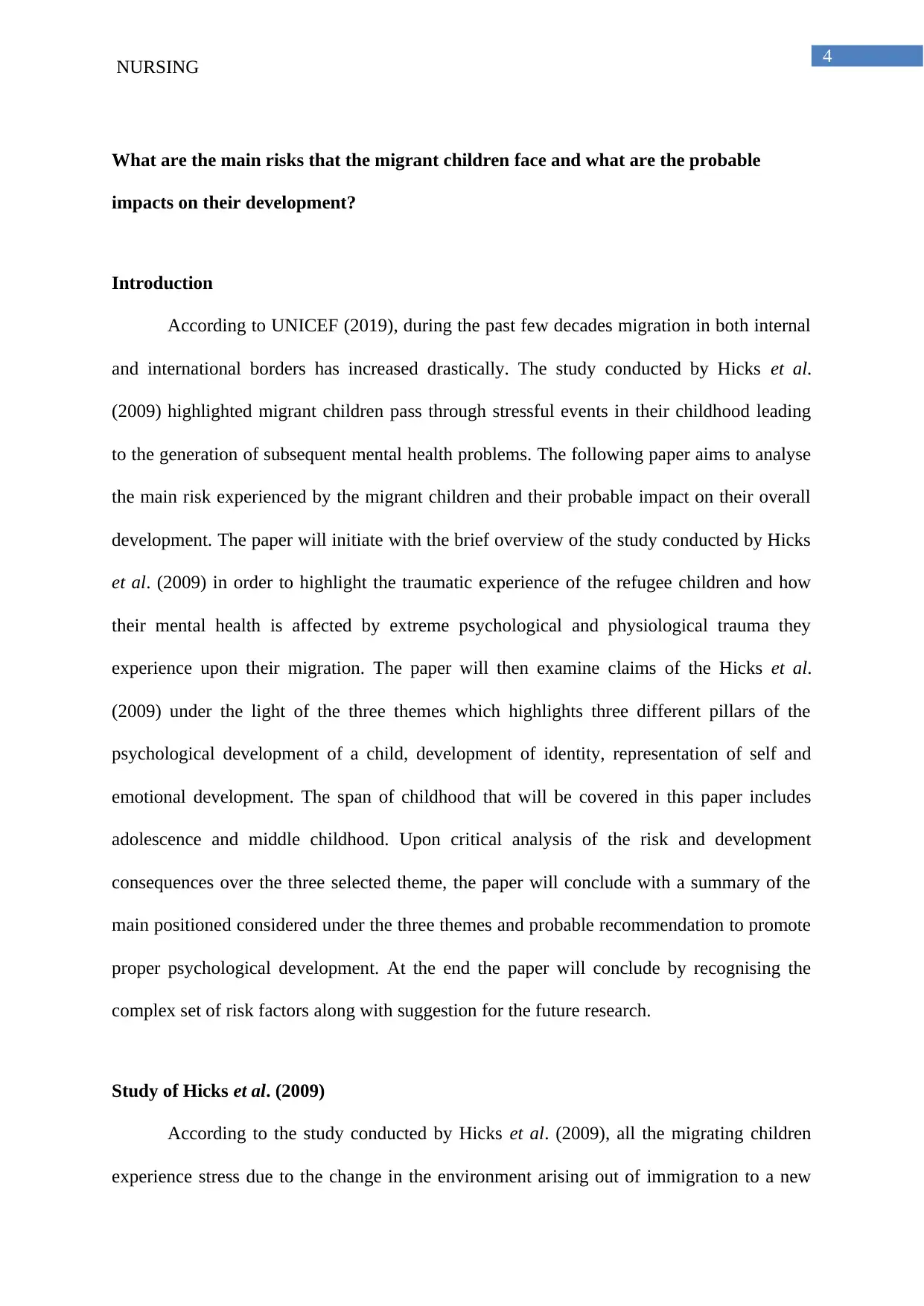
4
NURSING
What are the main risks that the migrant children face and what are the probable
impacts on their development?
Introduction
According to UNICEF (2019), during the past few decades migration in both internal
and international borders has increased drastically. The study conducted by Hicks et al.
(2009) highlighted migrant children pass through stressful events in their childhood leading
to the generation of subsequent mental health problems. The following paper aims to analyse
the main risk experienced by the migrant children and their probable impact on their overall
development. The paper will initiate with the brief overview of the study conducted by Hicks
et al. (2009) in order to highlight the traumatic experience of the refugee children and how
their mental health is affected by extreme psychological and physiological trauma they
experience upon their migration. The paper will then examine claims of the Hicks et al.
(2009) under the light of the three themes which highlights three different pillars of the
psychological development of a child, development of identity, representation of self and
emotional development. The span of childhood that will be covered in this paper includes
adolescence and middle childhood. Upon critical analysis of the risk and development
consequences over the three selected theme, the paper will conclude with a summary of the
main positioned considered under the three themes and probable recommendation to promote
proper psychological development. At the end the paper will conclude by recognising the
complex set of risk factors along with suggestion for the future research.
Study of Hicks et al. (2009)
According to the study conducted by Hicks et al. (2009), all the migrating children
experience stress due to the change in the environment arising out of immigration to a new
NURSING
What are the main risks that the migrant children face and what are the probable
impacts on their development?
Introduction
According to UNICEF (2019), during the past few decades migration in both internal
and international borders has increased drastically. The study conducted by Hicks et al.
(2009) highlighted migrant children pass through stressful events in their childhood leading
to the generation of subsequent mental health problems. The following paper aims to analyse
the main risk experienced by the migrant children and their probable impact on their overall
development. The paper will initiate with the brief overview of the study conducted by Hicks
et al. (2009) in order to highlight the traumatic experience of the refugee children and how
their mental health is affected by extreme psychological and physiological trauma they
experience upon their migration. The paper will then examine claims of the Hicks et al.
(2009) under the light of the three themes which highlights three different pillars of the
psychological development of a child, development of identity, representation of self and
emotional development. The span of childhood that will be covered in this paper includes
adolescence and middle childhood. Upon critical analysis of the risk and development
consequences over the three selected theme, the paper will conclude with a summary of the
main positioned considered under the three themes and probable recommendation to promote
proper psychological development. At the end the paper will conclude by recognising the
complex set of risk factors along with suggestion for the future research.
Study of Hicks et al. (2009)
According to the study conducted by Hicks et al. (2009), all the migrating children
experience stress due to the change in the environment arising out of immigration to a new
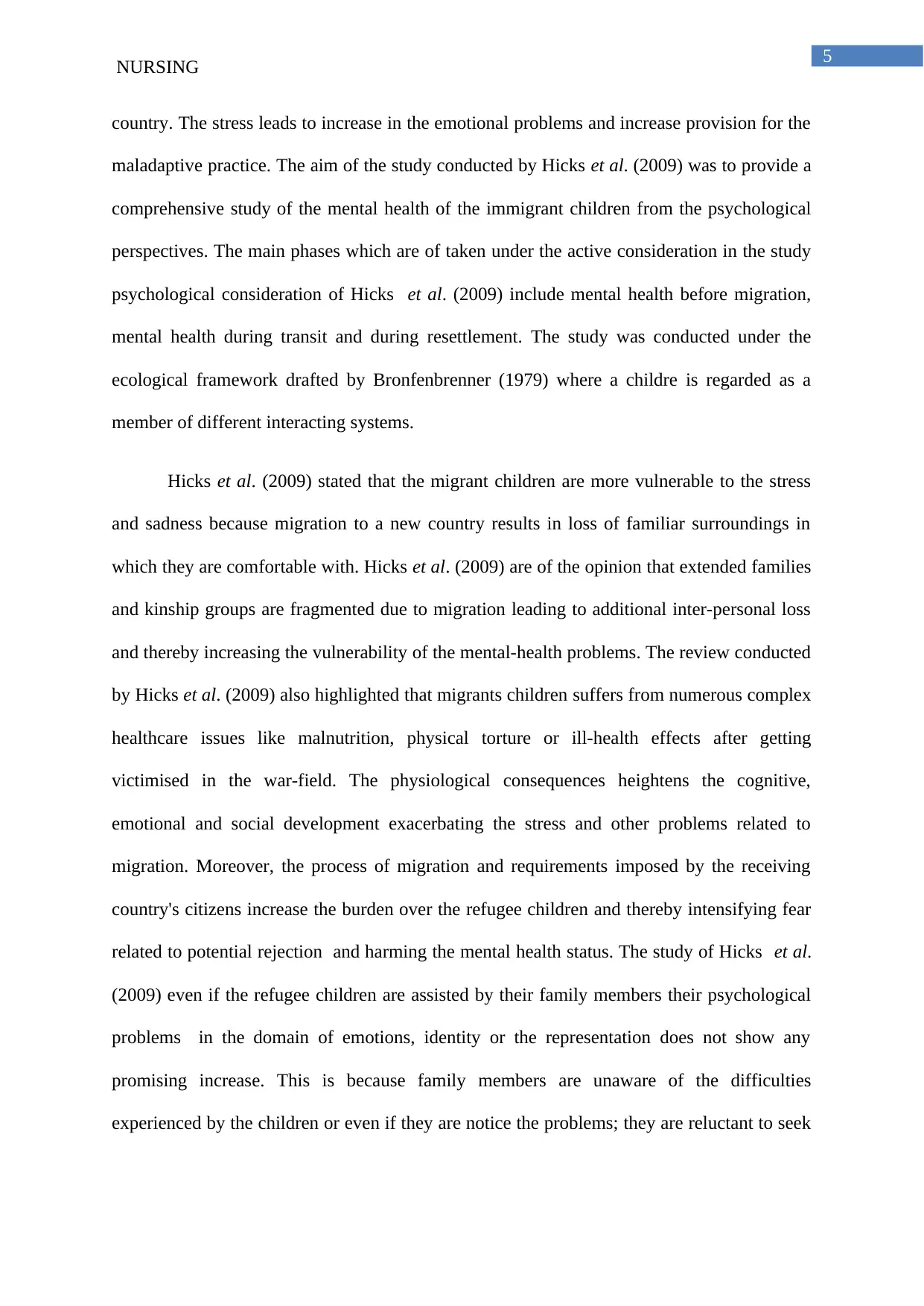
5
NURSING
country. The stress leads to increase in the emotional problems and increase provision for the
maladaptive practice. The aim of the study conducted by Hicks et al. (2009) was to provide a
comprehensive study of the mental health of the immigrant children from the psychological
perspectives. The main phases which are of taken under the active consideration in the study
psychological consideration of Hicks et al. (2009) include mental health before migration,
mental health during transit and during resettlement. The study was conducted under the
ecological framework drafted by Bronfenbrenner (1979) where a childre is regarded as a
member of different interacting systems.
Hicks et al. (2009) stated that the migrant children are more vulnerable to the stress
and sadness because migration to a new country results in loss of familiar surroundings in
which they are comfortable with. Hicks et al. (2009) are of the opinion that extended families
and kinship groups are fragmented due to migration leading to additional inter-personal loss
and thereby increasing the vulnerability of the mental-health problems. The review conducted
by Hicks et al. (2009) also highlighted that migrants children suffers from numerous complex
healthcare issues like malnutrition, physical torture or ill-health effects after getting
victimised in the war-field. The physiological consequences heightens the cognitive,
emotional and social development exacerbating the stress and other problems related to
migration. Moreover, the process of migration and requirements imposed by the receiving
country's citizens increase the burden over the refugee children and thereby intensifying fear
related to potential rejection and harming the mental health status. The study of Hicks et al.
(2009) even if the refugee children are assisted by their family members their psychological
problems in the domain of emotions, identity or the representation does not show any
promising increase. This is because family members are unaware of the difficulties
experienced by the children or even if they are notice the problems; they are reluctant to seek
NURSING
country. The stress leads to increase in the emotional problems and increase provision for the
maladaptive practice. The aim of the study conducted by Hicks et al. (2009) was to provide a
comprehensive study of the mental health of the immigrant children from the psychological
perspectives. The main phases which are of taken under the active consideration in the study
psychological consideration of Hicks et al. (2009) include mental health before migration,
mental health during transit and during resettlement. The study was conducted under the
ecological framework drafted by Bronfenbrenner (1979) where a childre is regarded as a
member of different interacting systems.
Hicks et al. (2009) stated that the migrant children are more vulnerable to the stress
and sadness because migration to a new country results in loss of familiar surroundings in
which they are comfortable with. Hicks et al. (2009) are of the opinion that extended families
and kinship groups are fragmented due to migration leading to additional inter-personal loss
and thereby increasing the vulnerability of the mental-health problems. The review conducted
by Hicks et al. (2009) also highlighted that migrants children suffers from numerous complex
healthcare issues like malnutrition, physical torture or ill-health effects after getting
victimised in the war-field. The physiological consequences heightens the cognitive,
emotional and social development exacerbating the stress and other problems related to
migration. Moreover, the process of migration and requirements imposed by the receiving
country's citizens increase the burden over the refugee children and thereby intensifying fear
related to potential rejection and harming the mental health status. The study of Hicks et al.
(2009) even if the refugee children are assisted by their family members their psychological
problems in the domain of emotions, identity or the representation does not show any
promising increase. This is because family members are unaware of the difficulties
experienced by the children or even if they are notice the problems; they are reluctant to seek
⊘ This is a preview!⊘
Do you want full access?
Subscribe today to unlock all pages.

Trusted by 1+ million students worldwide
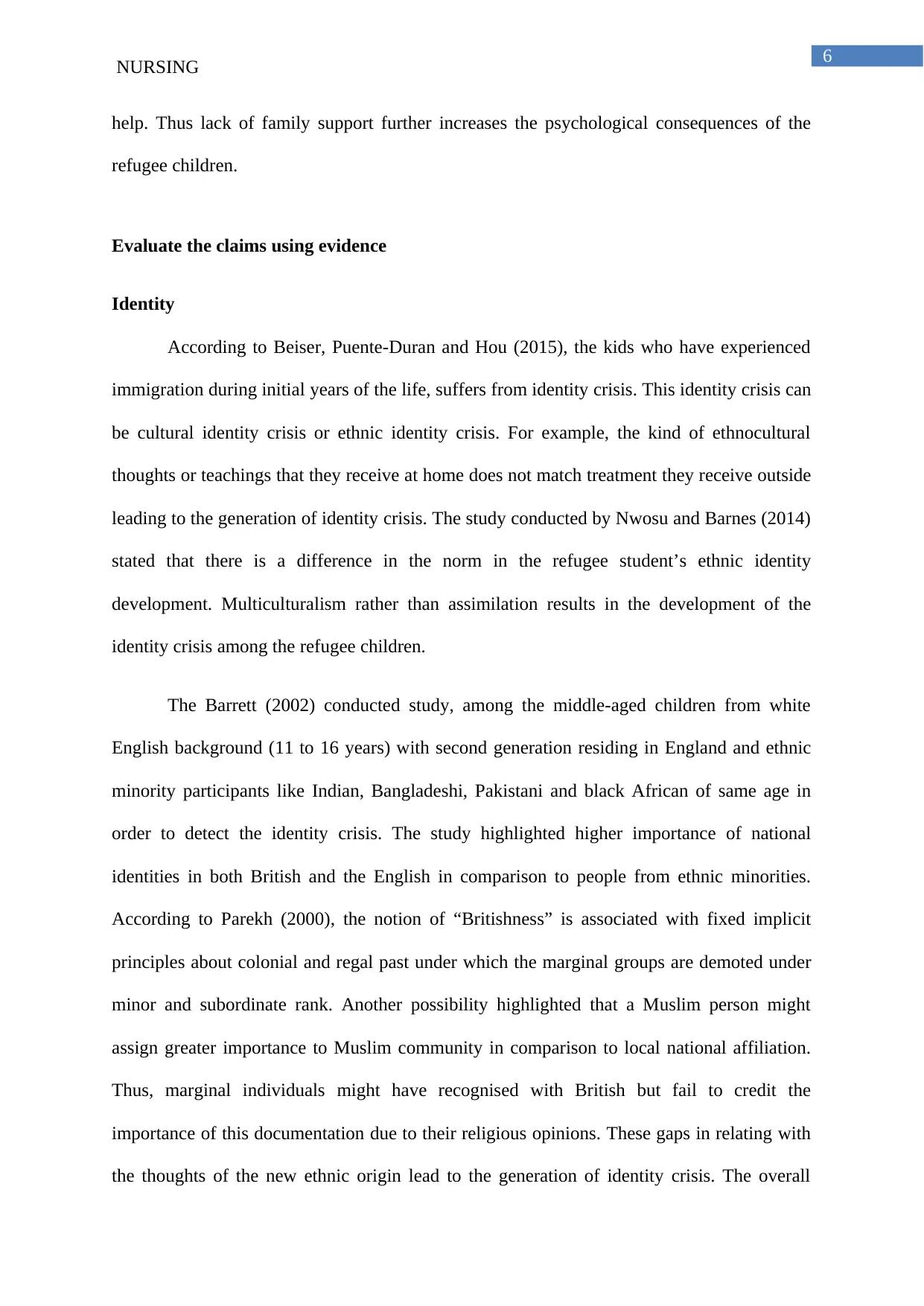
6
NURSING
help. Thus lack of family support further increases the psychological consequences of the
refugee children.
Evaluate the claims using evidence
Identity
According to Beiser, Puente-Duran and Hou (2015), the kids who have experienced
immigration during initial years of the life, suffers from identity crisis. This identity crisis can
be cultural identity crisis or ethnic identity crisis. For example, the kind of ethnocultural
thoughts or teachings that they receive at home does not match treatment they receive outside
leading to the generation of identity crisis. The study conducted by Nwosu and Barnes (2014)
stated that there is a difference in the norm in the refugee student’s ethnic identity
development. Multiculturalism rather than assimilation results in the development of the
identity crisis among the refugee children.
The Barrett (2002) conducted study, among the middle-aged children from white
English background (11 to 16 years) with second generation residing in England and ethnic
minority participants like Indian, Bangladeshi, Pakistani and black African of same age in
order to detect the identity crisis. The study highlighted higher importance of national
identities in both British and the English in comparison to people from ethnic minorities.
According to Parekh (2000), the notion of “Britishness” is associated with fixed implicit
principles about colonial and regal past under which the marginal groups are demoted under
minor and subordinate rank. Another possibility highlighted that a Muslim person might
assign greater importance to Muslim community in comparison to local national affiliation.
Thus, marginal individuals might have recognised with British but fail to credit the
importance of this documentation due to their religious opinions. These gaps in relating with
the thoughts of the new ethnic origin lead to the generation of identity crisis. The overall
NURSING
help. Thus lack of family support further increases the psychological consequences of the
refugee children.
Evaluate the claims using evidence
Identity
According to Beiser, Puente-Duran and Hou (2015), the kids who have experienced
immigration during initial years of the life, suffers from identity crisis. This identity crisis can
be cultural identity crisis or ethnic identity crisis. For example, the kind of ethnocultural
thoughts or teachings that they receive at home does not match treatment they receive outside
leading to the generation of identity crisis. The study conducted by Nwosu and Barnes (2014)
stated that there is a difference in the norm in the refugee student’s ethnic identity
development. Multiculturalism rather than assimilation results in the development of the
identity crisis among the refugee children.
The Barrett (2002) conducted study, among the middle-aged children from white
English background (11 to 16 years) with second generation residing in England and ethnic
minority participants like Indian, Bangladeshi, Pakistani and black African of same age in
order to detect the identity crisis. The study highlighted higher importance of national
identities in both British and the English in comparison to people from ethnic minorities.
According to Parekh (2000), the notion of “Britishness” is associated with fixed implicit
principles about colonial and regal past under which the marginal groups are demoted under
minor and subordinate rank. Another possibility highlighted that a Muslim person might
assign greater importance to Muslim community in comparison to local national affiliation.
Thus, marginal individuals might have recognised with British but fail to credit the
importance of this documentation due to their religious opinions. These gaps in relating with
the thoughts of the new ethnic origin lead to the generation of identity crisis. The overall
Paraphrase This Document
Need a fresh take? Get an instant paraphrase of this document with our AI Paraphraser
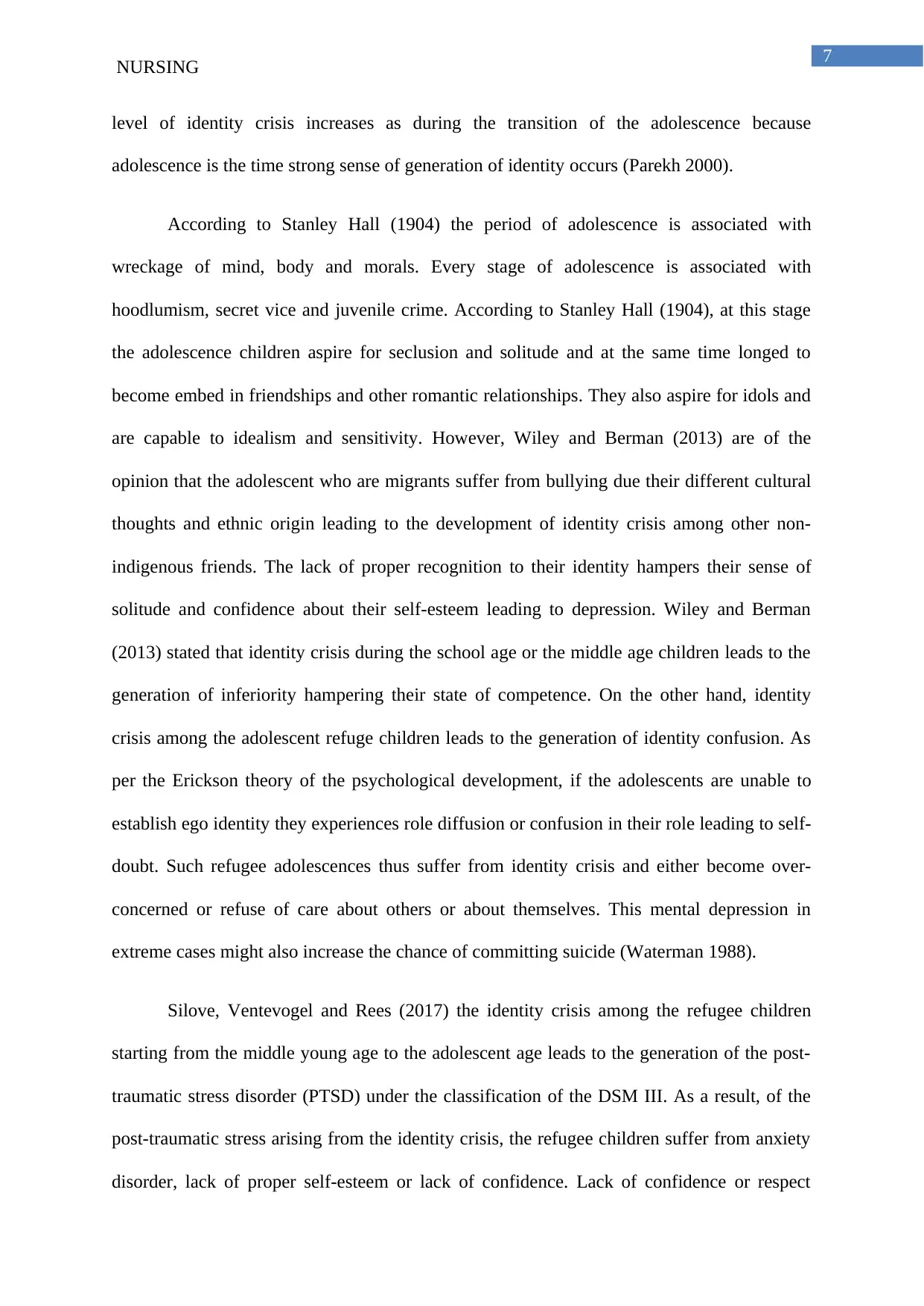
7
NURSING
level of identity crisis increases as during the transition of the adolescence because
adolescence is the time strong sense of generation of identity occurs (Parekh 2000).
According to Stanley Hall (1904) the period of adolescence is associated with
wreckage of mind, body and morals. Every stage of adolescence is associated with
hoodlumism, secret vice and juvenile crime. According to Stanley Hall (1904), at this stage
the adolescence children aspire for seclusion and solitude and at the same time longed to
become embed in friendships and other romantic relationships. They also aspire for idols and
are capable to idealism and sensitivity. However, Wiley and Berman (2013) are of the
opinion that the adolescent who are migrants suffer from bullying due their different cultural
thoughts and ethnic origin leading to the development of identity crisis among other non-
indigenous friends. The lack of proper recognition to their identity hampers their sense of
solitude and confidence about their self-esteem leading to depression. Wiley and Berman
(2013) stated that identity crisis during the school age or the middle age children leads to the
generation of inferiority hampering their state of competence. On the other hand, identity
crisis among the adolescent refuge children leads to the generation of identity confusion. As
per the Erickson theory of the psychological development, if the adolescents are unable to
establish ego identity they experiences role diffusion or confusion in their role leading to self-
doubt. Such refugee adolescences thus suffer from identity crisis and either become over-
concerned or refuse of care about others or about themselves. This mental depression in
extreme cases might also increase the chance of committing suicide (Waterman 1988).
Silove, Ventevogel and Rees (2017) the identity crisis among the refugee children
starting from the middle young age to the adolescent age leads to the generation of the post-
traumatic stress disorder (PTSD) under the classification of the DSM III. As a result, of the
post-traumatic stress arising from the identity crisis, the refugee children suffer from anxiety
disorder, lack of proper self-esteem or lack of confidence. Lack of confidence or respect
NURSING
level of identity crisis increases as during the transition of the adolescence because
adolescence is the time strong sense of generation of identity occurs (Parekh 2000).
According to Stanley Hall (1904) the period of adolescence is associated with
wreckage of mind, body and morals. Every stage of adolescence is associated with
hoodlumism, secret vice and juvenile crime. According to Stanley Hall (1904), at this stage
the adolescence children aspire for seclusion and solitude and at the same time longed to
become embed in friendships and other romantic relationships. They also aspire for idols and
are capable to idealism and sensitivity. However, Wiley and Berman (2013) are of the
opinion that the adolescent who are migrants suffer from bullying due their different cultural
thoughts and ethnic origin leading to the development of identity crisis among other non-
indigenous friends. The lack of proper recognition to their identity hampers their sense of
solitude and confidence about their self-esteem leading to depression. Wiley and Berman
(2013) stated that identity crisis during the school age or the middle age children leads to the
generation of inferiority hampering their state of competence. On the other hand, identity
crisis among the adolescent refuge children leads to the generation of identity confusion. As
per the Erickson theory of the psychological development, if the adolescents are unable to
establish ego identity they experiences role diffusion or confusion in their role leading to self-
doubt. Such refugee adolescences thus suffer from identity crisis and either become over-
concerned or refuse of care about others or about themselves. This mental depression in
extreme cases might also increase the chance of committing suicide (Waterman 1988).
Silove, Ventevogel and Rees (2017) the identity crisis among the refugee children
starting from the middle young age to the adolescent age leads to the generation of the post-
traumatic stress disorder (PTSD) under the classification of the DSM III. As a result, of the
post-traumatic stress arising from the identity crisis, the refugee children suffer from anxiety
disorder, lack of proper self-esteem or lack of confidence. Lack of confidence or respect
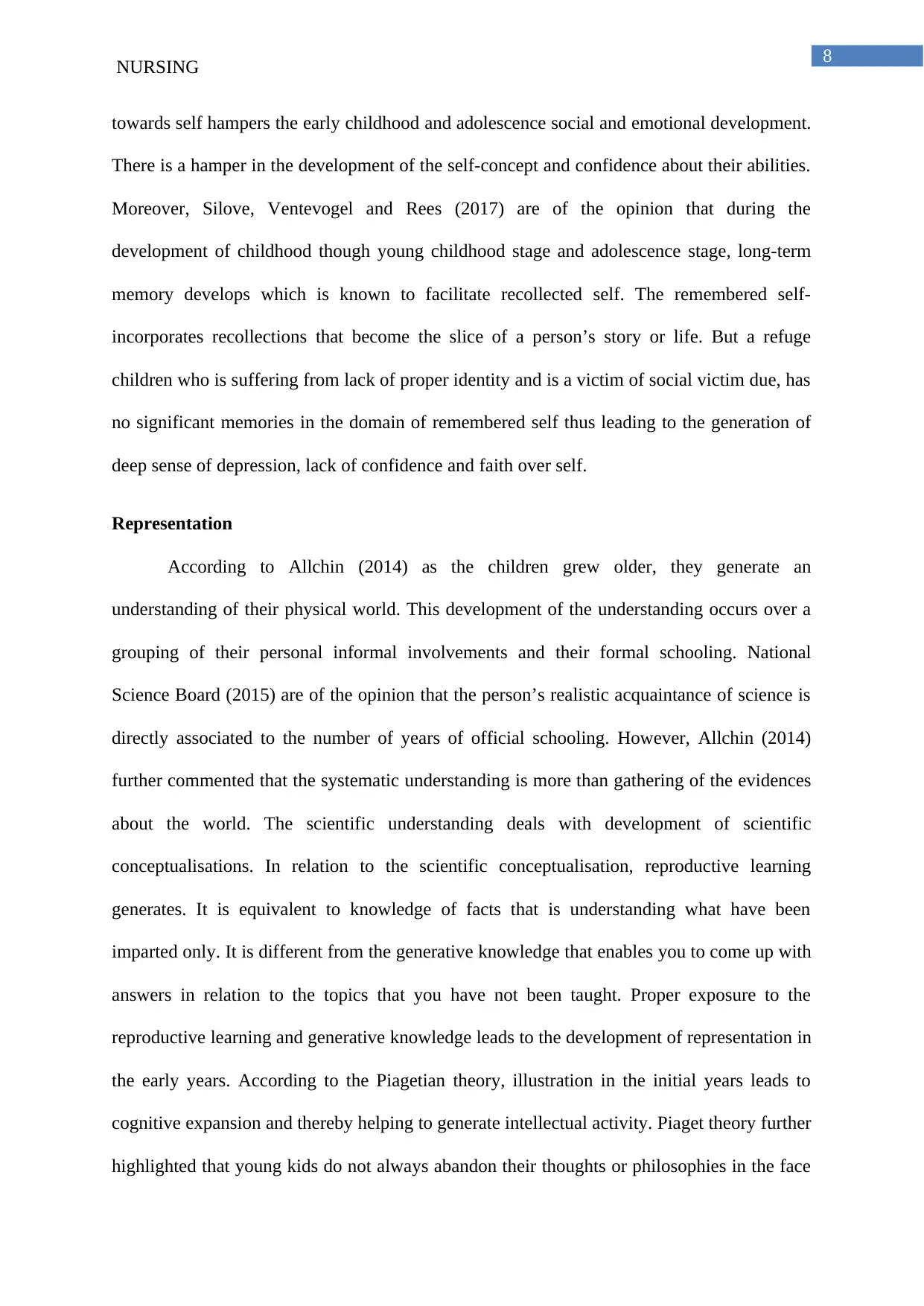
8
NURSING
towards self hampers the early childhood and adolescence social and emotional development.
There is a hamper in the development of the self-concept and confidence about their abilities.
Moreover, Silove, Ventevogel and Rees (2017) are of the opinion that during the
development of childhood though young childhood stage and adolescence stage, long-term
memory develops which is known to facilitate recollected self. The remembered self-
incorporates recollections that become the slice of a person’s story or life. But a refuge
children who is suffering from lack of proper identity and is a victim of social victim due, has
no significant memories in the domain of remembered self thus leading to the generation of
deep sense of depression, lack of confidence and faith over self.
Representation
According to Allchin (2014) as the children grew older, they generate an
understanding of their physical world. This development of the understanding occurs over a
grouping of their personal informal involvements and their formal schooling. National
Science Board (2015) are of the opinion that the person’s realistic acquaintance of science is
directly associated to the number of years of official schooling. However, Allchin (2014)
further commented that the systematic understanding is more than gathering of the evidences
about the world. The scientific understanding deals with development of scientific
conceptualisations. In relation to the scientific conceptualisation, reproductive learning
generates. It is equivalent to knowledge of facts that is understanding what have been
imparted only. It is different from the generative knowledge that enables you to come up with
answers in relation to the topics that you have not been taught. Proper exposure to the
reproductive learning and generative knowledge leads to the development of representation in
the early years. According to the Piagetian theory, illustration in the initial years leads to
cognitive expansion and thereby helping to generate intellectual activity. Piaget theory further
highlighted that young kids do not always abandon their thoughts or philosophies in the face
NURSING
towards self hampers the early childhood and adolescence social and emotional development.
There is a hamper in the development of the self-concept and confidence about their abilities.
Moreover, Silove, Ventevogel and Rees (2017) are of the opinion that during the
development of childhood though young childhood stage and adolescence stage, long-term
memory develops which is known to facilitate recollected self. The remembered self-
incorporates recollections that become the slice of a person’s story or life. But a refuge
children who is suffering from lack of proper identity and is a victim of social victim due, has
no significant memories in the domain of remembered self thus leading to the generation of
deep sense of depression, lack of confidence and faith over self.
Representation
According to Allchin (2014) as the children grew older, they generate an
understanding of their physical world. This development of the understanding occurs over a
grouping of their personal informal involvements and their formal schooling. National
Science Board (2015) are of the opinion that the person’s realistic acquaintance of science is
directly associated to the number of years of official schooling. However, Allchin (2014)
further commented that the systematic understanding is more than gathering of the evidences
about the world. The scientific understanding deals with development of scientific
conceptualisations. In relation to the scientific conceptualisation, reproductive learning
generates. It is equivalent to knowledge of facts that is understanding what have been
imparted only. It is different from the generative knowledge that enables you to come up with
answers in relation to the topics that you have not been taught. Proper exposure to the
reproductive learning and generative knowledge leads to the development of representation in
the early years. According to the Piagetian theory, illustration in the initial years leads to
cognitive expansion and thereby helping to generate intellectual activity. Piaget theory further
highlighted that young kids do not always abandon their thoughts or philosophies in the face
⊘ This is a preview!⊘
Do you want full access?
Subscribe today to unlock all pages.

Trusted by 1+ million students worldwide
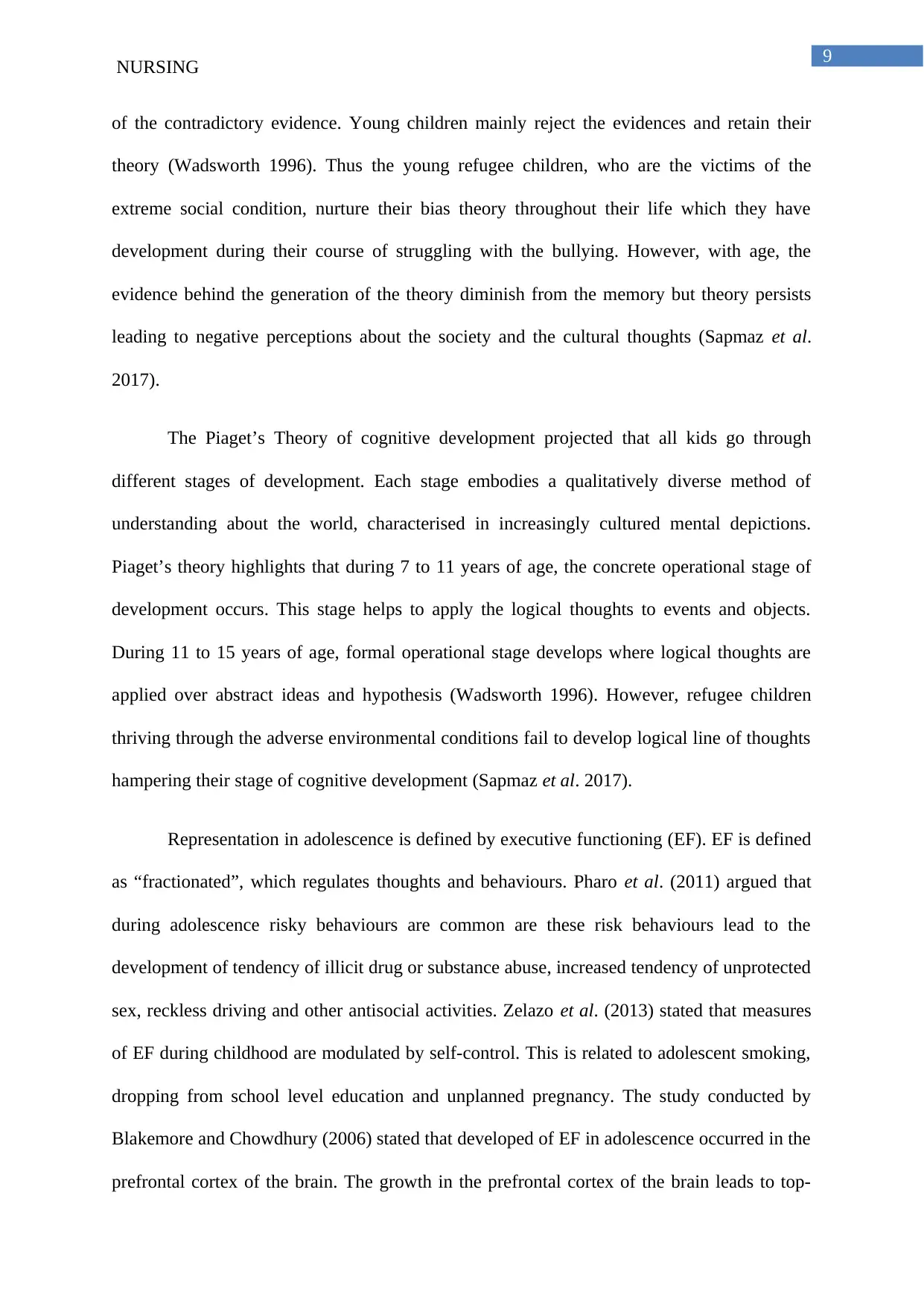
9
NURSING
of the contradictory evidence. Young children mainly reject the evidences and retain their
theory (Wadsworth 1996). Thus the young refugee children, who are the victims of the
extreme social condition, nurture their bias theory throughout their life which they have
development during their course of struggling with the bullying. However, with age, the
evidence behind the generation of the theory diminish from the memory but theory persists
leading to negative perceptions about the society and the cultural thoughts (Sapmaz et al.
2017).
The Piaget’s Theory of cognitive development projected that all kids go through
different stages of development. Each stage embodies a qualitatively diverse method of
understanding about the world, characterised in increasingly cultured mental depictions.
Piaget’s theory highlights that during 7 to 11 years of age, the concrete operational stage of
development occurs. This stage helps to apply the logical thoughts to events and objects.
During 11 to 15 years of age, formal operational stage develops where logical thoughts are
applied over abstract ideas and hypothesis (Wadsworth 1996). However, refugee children
thriving through the adverse environmental conditions fail to develop logical line of thoughts
hampering their stage of cognitive development (Sapmaz et al. 2017).
Representation in adolescence is defined by executive functioning (EF). EF is defined
as “fractionated”, which regulates thoughts and behaviours. Pharo et al. (2011) argued that
during adolescence risky behaviours are common are these risk behaviours lead to the
development of tendency of illicit drug or substance abuse, increased tendency of unprotected
sex, reckless driving and other antisocial activities. Zelazo et al. (2013) stated that measures
of EF during childhood are modulated by self-control. This is related to adolescent smoking,
dropping from school level education and unplanned pregnancy. The study conducted by
Blakemore and Chowdhury (2006) stated that developed of EF in adolescence occurred in the
prefrontal cortex of the brain. The growth in the prefrontal cortex of the brain leads to top-
NURSING
of the contradictory evidence. Young children mainly reject the evidences and retain their
theory (Wadsworth 1996). Thus the young refugee children, who are the victims of the
extreme social condition, nurture their bias theory throughout their life which they have
development during their course of struggling with the bullying. However, with age, the
evidence behind the generation of the theory diminish from the memory but theory persists
leading to negative perceptions about the society and the cultural thoughts (Sapmaz et al.
2017).
The Piaget’s Theory of cognitive development projected that all kids go through
different stages of development. Each stage embodies a qualitatively diverse method of
understanding about the world, characterised in increasingly cultured mental depictions.
Piaget’s theory highlights that during 7 to 11 years of age, the concrete operational stage of
development occurs. This stage helps to apply the logical thoughts to events and objects.
During 11 to 15 years of age, formal operational stage develops where logical thoughts are
applied over abstract ideas and hypothesis (Wadsworth 1996). However, refugee children
thriving through the adverse environmental conditions fail to develop logical line of thoughts
hampering their stage of cognitive development (Sapmaz et al. 2017).
Representation in adolescence is defined by executive functioning (EF). EF is defined
as “fractionated”, which regulates thoughts and behaviours. Pharo et al. (2011) argued that
during adolescence risky behaviours are common are these risk behaviours lead to the
development of tendency of illicit drug or substance abuse, increased tendency of unprotected
sex, reckless driving and other antisocial activities. Zelazo et al. (2013) stated that measures
of EF during childhood are modulated by self-control. This is related to adolescent smoking,
dropping from school level education and unplanned pregnancy. The study conducted by
Blakemore and Chowdhury (2006) stated that developed of EF in adolescence occurred in the
prefrontal cortex of the brain. The growth in the prefrontal cortex of the brain leads to top-
Paraphrase This Document
Need a fresh take? Get an instant paraphrase of this document with our AI Paraphraser
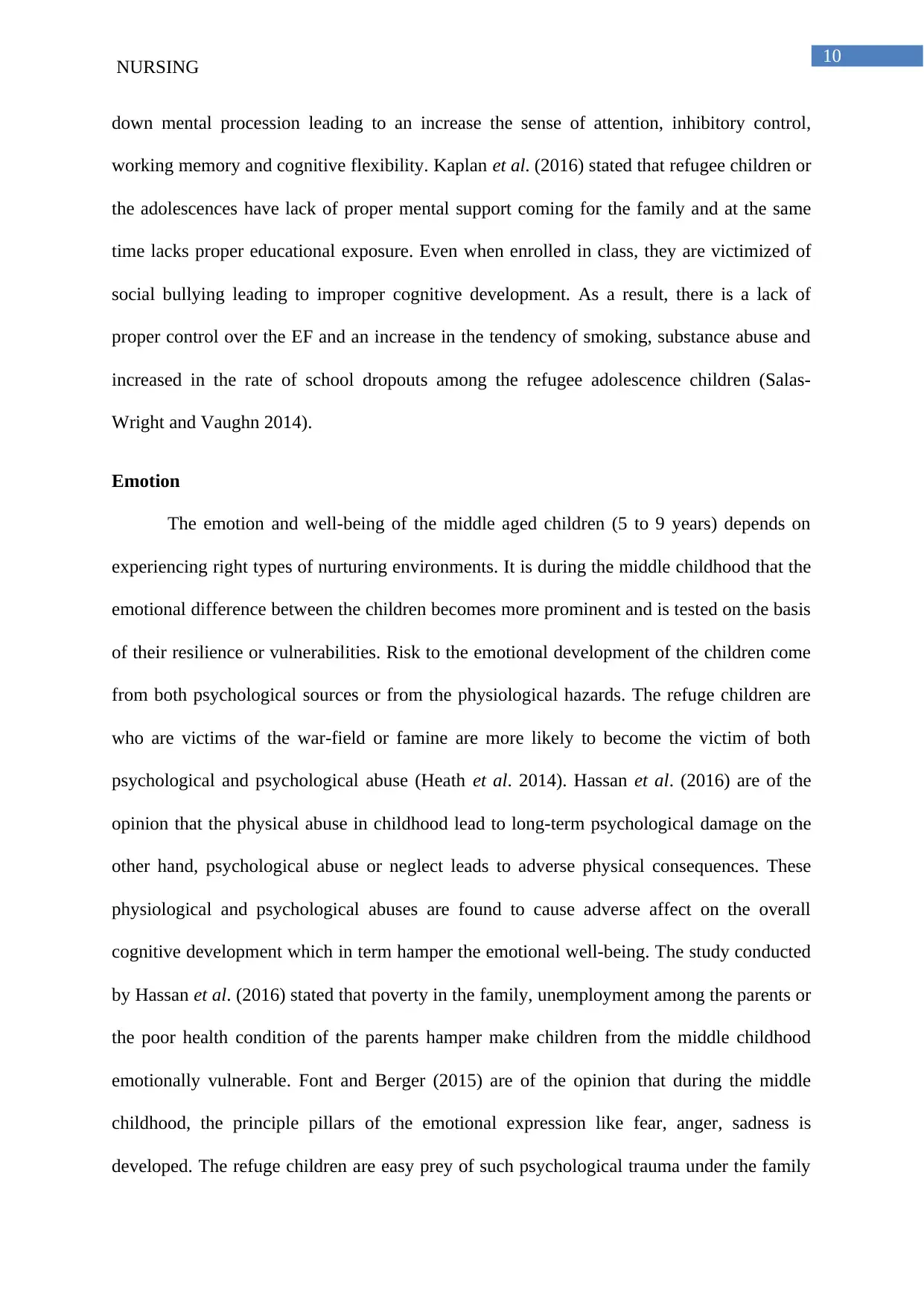
10
NURSING
down mental procession leading to an increase the sense of attention, inhibitory control,
working memory and cognitive flexibility. Kaplan et al. (2016) stated that refugee children or
the adolescences have lack of proper mental support coming for the family and at the same
time lacks proper educational exposure. Even when enrolled in class, they are victimized of
social bullying leading to improper cognitive development. As a result, there is a lack of
proper control over the EF and an increase in the tendency of smoking, substance abuse and
increased in the rate of school dropouts among the refugee adolescence children (Salas-
Wright and Vaughn 2014).
Emotion
The emotion and well-being of the middle aged children (5 to 9 years) depends on
experiencing right types of nurturing environments. It is during the middle childhood that the
emotional difference between the children becomes more prominent and is tested on the basis
of their resilience or vulnerabilities. Risk to the emotional development of the children come
from both psychological sources or from the physiological hazards. The refuge children are
who are victims of the war-field or famine are more likely to become the victim of both
psychological and psychological abuse (Heath et al. 2014). Hassan et al. (2016) are of the
opinion that the physical abuse in childhood lead to long-term psychological damage on the
other hand, psychological abuse or neglect leads to adverse physical consequences. These
physiological and psychological abuses are found to cause adverse affect on the overall
cognitive development which in term hamper the emotional well-being. The study conducted
by Hassan et al. (2016) stated that poverty in the family, unemployment among the parents or
the poor health condition of the parents hamper make children from the middle childhood
emotionally vulnerable. Font and Berger (2015) are of the opinion that during the middle
childhood, the principle pillars of the emotional expression like fear, anger, sadness is
developed. The refuge children are easy prey of such psychological trauma under the family
NURSING
down mental procession leading to an increase the sense of attention, inhibitory control,
working memory and cognitive flexibility. Kaplan et al. (2016) stated that refugee children or
the adolescences have lack of proper mental support coming for the family and at the same
time lacks proper educational exposure. Even when enrolled in class, they are victimized of
social bullying leading to improper cognitive development. As a result, there is a lack of
proper control over the EF and an increase in the tendency of smoking, substance abuse and
increased in the rate of school dropouts among the refugee adolescence children (Salas-
Wright and Vaughn 2014).
Emotion
The emotion and well-being of the middle aged children (5 to 9 years) depends on
experiencing right types of nurturing environments. It is during the middle childhood that the
emotional difference between the children becomes more prominent and is tested on the basis
of their resilience or vulnerabilities. Risk to the emotional development of the children come
from both psychological sources or from the physiological hazards. The refuge children are
who are victims of the war-field or famine are more likely to become the victim of both
psychological and psychological abuse (Heath et al. 2014). Hassan et al. (2016) are of the
opinion that the physical abuse in childhood lead to long-term psychological damage on the
other hand, psychological abuse or neglect leads to adverse physical consequences. These
physiological and psychological abuses are found to cause adverse affect on the overall
cognitive development which in term hamper the emotional well-being. The study conducted
by Hassan et al. (2016) stated that poverty in the family, unemployment among the parents or
the poor health condition of the parents hamper make children from the middle childhood
emotionally vulnerable. Font and Berger (2015) are of the opinion that during the middle
childhood, the principle pillars of the emotional expression like fear, anger, sadness is
developed. The refuge children are easy prey of such psychological trauma under the family
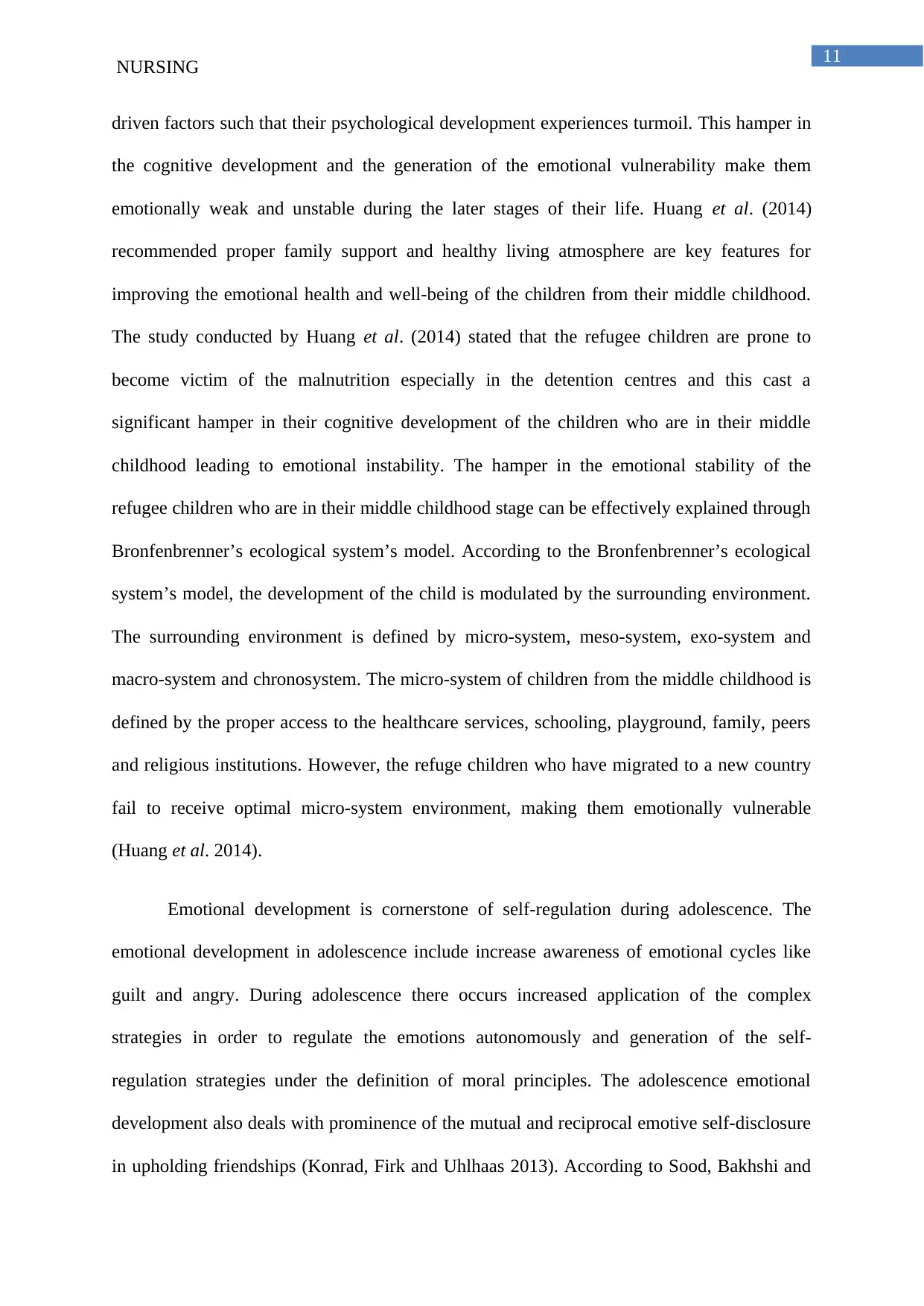
11
NURSING
driven factors such that their psychological development experiences turmoil. This hamper in
the cognitive development and the generation of the emotional vulnerability make them
emotionally weak and unstable during the later stages of their life. Huang et al. (2014)
recommended proper family support and healthy living atmosphere are key features for
improving the emotional health and well-being of the children from their middle childhood.
The study conducted by Huang et al. (2014) stated that the refugee children are prone to
become victim of the malnutrition especially in the detention centres and this cast a
significant hamper in their cognitive development of the children who are in their middle
childhood leading to emotional instability. The hamper in the emotional stability of the
refugee children who are in their middle childhood stage can be effectively explained through
Bronfenbrenner’s ecological system’s model. According to the Bronfenbrenner’s ecological
system’s model, the development of the child is modulated by the surrounding environment.
The surrounding environment is defined by micro-system, meso-system, exo-system and
macro-system and chronosystem. The micro-system of children from the middle childhood is
defined by the proper access to the healthcare services, schooling, playground, family, peers
and religious institutions. However, the refuge children who have migrated to a new country
fail to receive optimal micro-system environment, making them emotionally vulnerable
(Huang et al. 2014).
Emotional development is cornerstone of self-regulation during adolescence. The
emotional development in adolescence include increase awareness of emotional cycles like
guilt and angry. During adolescence there occurs increased application of the complex
strategies in order to regulate the emotions autonomously and generation of the self-
regulation strategies under the definition of moral principles. The adolescence emotional
development also deals with prominence of the mutual and reciprocal emotive self-disclosure
in upholding friendships (Konrad, Firk and Uhlhaas 2013). According to Sood, Bakhshi and
NURSING
driven factors such that their psychological development experiences turmoil. This hamper in
the cognitive development and the generation of the emotional vulnerability make them
emotionally weak and unstable during the later stages of their life. Huang et al. (2014)
recommended proper family support and healthy living atmosphere are key features for
improving the emotional health and well-being of the children from their middle childhood.
The study conducted by Huang et al. (2014) stated that the refugee children are prone to
become victim of the malnutrition especially in the detention centres and this cast a
significant hamper in their cognitive development of the children who are in their middle
childhood leading to emotional instability. The hamper in the emotional stability of the
refugee children who are in their middle childhood stage can be effectively explained through
Bronfenbrenner’s ecological system’s model. According to the Bronfenbrenner’s ecological
system’s model, the development of the child is modulated by the surrounding environment.
The surrounding environment is defined by micro-system, meso-system, exo-system and
macro-system and chronosystem. The micro-system of children from the middle childhood is
defined by the proper access to the healthcare services, schooling, playground, family, peers
and religious institutions. However, the refuge children who have migrated to a new country
fail to receive optimal micro-system environment, making them emotionally vulnerable
(Huang et al. 2014).
Emotional development is cornerstone of self-regulation during adolescence. The
emotional development in adolescence include increase awareness of emotional cycles like
guilt and angry. During adolescence there occurs increased application of the complex
strategies in order to regulate the emotions autonomously and generation of the self-
regulation strategies under the definition of moral principles. The adolescence emotional
development also deals with prominence of the mutual and reciprocal emotive self-disclosure
in upholding friendships (Konrad, Firk and Uhlhaas 2013). According to Sood, Bakhshi and
⊘ This is a preview!⊘
Do you want full access?
Subscribe today to unlock all pages.

Trusted by 1+ million students worldwide
1 out of 21
Related Documents
Your All-in-One AI-Powered Toolkit for Academic Success.
+13062052269
info@desklib.com
Available 24*7 on WhatsApp / Email
![[object Object]](/_next/static/media/star-bottom.7253800d.svg)
Unlock your academic potential
Copyright © 2020–2025 A2Z Services. All Rights Reserved. Developed and managed by ZUCOL.




